

Historical Tales | News | Vampires | Zombies | Werewolves
Virtual Academy | Weapons | Links | Forum
 |
 |
Historical Tales | News | Vampires | Zombies | Werewolves Virtual Academy | Weapons | Links | Forum |
Return to Part I
Muscular & Skeletal System
Vocal Folds: Early-stage zombies sound somewhat similar to their human selves. They try to form words and sentences, and they can vary the pitch and volume of their voice. However, they are unable to speak clearly because of degradation in the language centers of their brains (imagine a severely drunk person trying to speak). They may growl, hiss and even shriek to express their emotions. As time passes, their vocal cords deteriorate and they begin to emit some truly horrible noises—nothing like the steady groan of fictional zombies. Mid-stage zombies will wheeze and gurgle due to excess fluid in their lungs. Later, as that fluid dries up, zombies will emit a chilling, guttural sound often referred to as the ôzombie rattle."
Muscles/Connective Tissue: The muscle fibers of the hands, forearms and jaw become concentrated and take on the consistency of nylon rope when contracted. Ligaments and tendons thicken in response to the added stress. Using their grip, zombies can exert about 400 pounds per square inch of pressure—approximately 10 times that of normal humans and close to the gripping strength of a bald eagle. That's more than enough force to crush bones. This gripping strength is fairly consistent among all zombies, although those with larger hands have an advantage in that they can exert that pressure over a larger area. Lastly, while early-stage zombies have been observed overturning cars to get at their prey, their ability to lift heavy objects goes downhill fast after transformation. However, a zombie's bite and grip remain extremely powerful even in later stages.
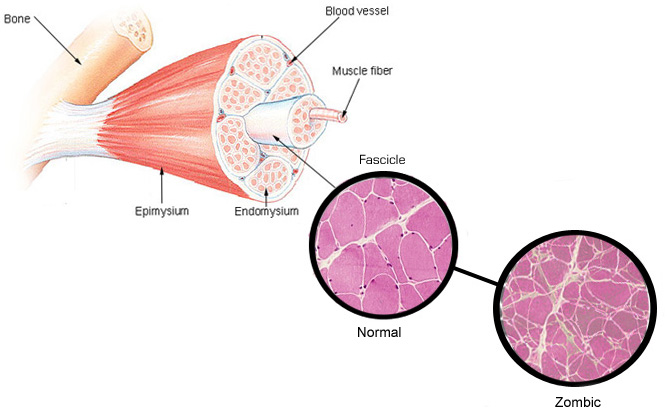 |
|
Comparison between human and zombic muscle tissue. Note how the latter is much more interwoven. |
 |
|
A normal jaw (L) and a zombic jaw (R). Note the larger jawbone and thicker muscle of the latter. |
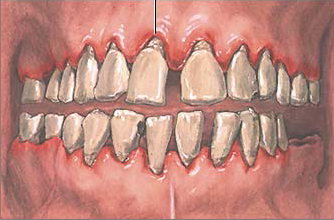 |
| A typical early-stager's teeth |
Teeth:
Although early-stagers are smart enough to use heavy objects (or the pavement) to shatter skulls, older zombies are much less savvy in their eating habits. Unfortunately, zombic teeth are not adapted to the powerful forces exerted on them by the jaw, causing them to crack and fall out. Eventually, all the teeth are gone, and the zombie is forced to chew with its exposed jawbones, which ultimately become cracked and worn down as well.
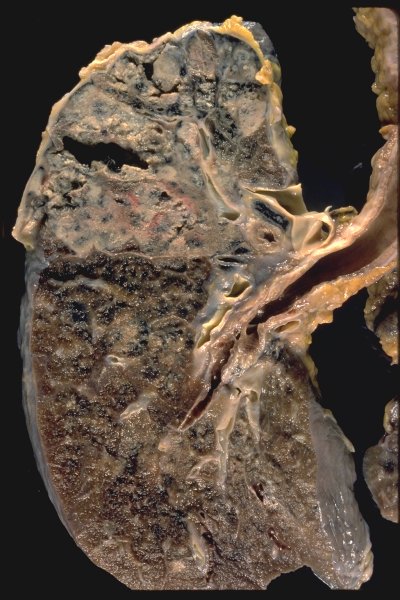 |
| Late-stage zombic lung tissue |
Respiration: As a result of their slowed circulation and lack of higher brain functions, a zombie's oxygen usage is even lower than a vampire's. However, due to lung damage, their rate of breathing starts off at about the same level as a vampire and gradually increases to that of a human as they lose more and more of their lung tissue. Interestingly, although zombies retain enough primitive instinct to hold their breath underwater, they usually can't hold it for very long, and will generally start drowning within a minute. Not only are they poor swimmers, they'll become overwhelmed by a strange sense of panic when in deep water, and will therefore expend more energy and oxygen trying to escape. Like fainting goats, their muscles will often "lock up" as they drown, giving the illusion of a quick death. Early-stage zombies are an exception to these rules, as they've been observed to ambush prey from underwater, thanks to their superior intelligence and lung function.
Saliva: Unlike vampire victims, those attacked by zombies can sustain horrific injuries as they are literally eaten alive. However, because zombic saliva contains a potent coagulant (as opposed to the anticoagulants in vampiric saliva), the victim is usually able to survive having flesh and even entire limbs chewed off as they (luckily) go unconscious from a combination of intense agony, acute blood loss, and the narcotic-like effect of zombic saliva—which also has the effect of significantly lowering blood pressure and cardiac output so that open wounds experience minimal blood flow. As long as the victim remains intact enough so that their heart keeps beating, they will usually transform into a zombie as well.
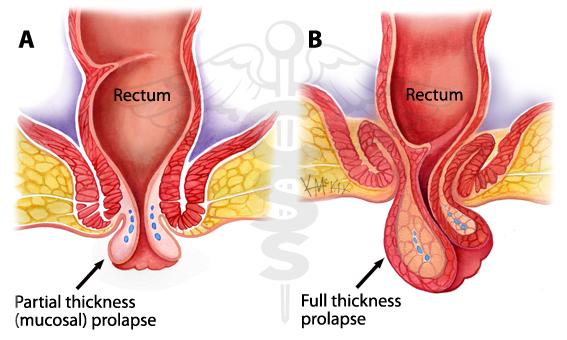 |
|
The degrees of rectal prolapse suffered by Stage II (A) and Stage III zombies (B) |
 |
|
An example of urinary retention with a greatly enlarged bladder |
Fat: Like vampires, zombies also lose weight during and after the transformation, though the cause behind the latter is quite different. While the diets and lifestyles of vampires and zombies are polar opposites, zombies will gradually lose additional body fat as their intestinal tracts rot and become increasingly inefficient at extracting nutrients from food, which is further exacerbated by parasites such as tapeworms. By the time a zombie enters Stage III, it will have become as emaciated (and hairless) as a decade-old vampire.
Dietary Restrictions: Unlike vampires, zombies can indeed survive on just animals, though they definitely prefer human flesh. Curiously, while they seem to enjoy carrion, zombies will always ignore necrotic human flesh—even when on the verge of starving to death—which is likely why they never try to eat each other. Another interesting difference from vampires is that, when force-fed, zombies can keep almost anything down, and chemicals such as caffeine and alcohol have very little effect on them.
 |
| A pool of dried zombie blood |
Blood:
Zombic blood is thick and dark, hence the nickname "zombie oil." As with vampires, higher iron and bile levels cause the blood to darken drastically, and total oxygen storage will gradually increase after transformation. A zombie's slowed circulation also improves clotting, but at the cost of tissue integrity. Also like vampires, it takes a while for the blood to fully darken, and it won't reach its full clotting and oxygen storage potential until after a few months.
Heart:
As with vampires, zombic blood is circulated by skeletal muscle rather than the heart. Cardiac paralysis was once a confounding mystery regarding vampiric and zombic transformation, until it was chalked up to simply being the result of involuntary muscle spasms slowly rendering the heart obsolete as these creatures evolved. What's known for sure is that if vampires and zombies had to rely on their heart for survival, a single well-placed bullet could easily paralyze the organ and kill them (as would gradual decomposition for zombies). However, this doesn't mean they can live without a heart. Even though it no longer beats—and the blood clots too quickly to allow fatal blood loss—it's still the hub of their circulatory system, as it connects all the veins and arteries together. If it were removed, either through trauma or surgery, fatal thrombosis would occur throughout the body.
 |
|
Varicose veins are a common side effect of a zombie's sluggish circulation. |
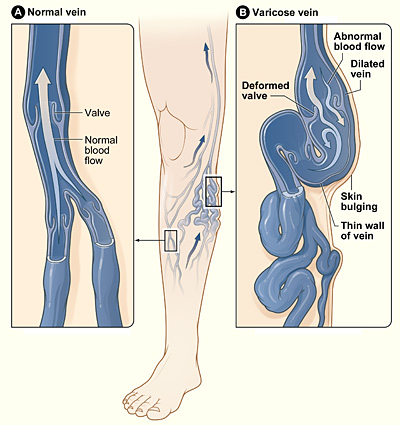 |
| A diagram of zombic vein dysfunction |
Adrenaline: As with vampires, zombies also produce large quantities of this hormone/neurotransmitter during stress. While it makes them more powerful during combat, it also causes them to drown faster when trying to escape from deep water.
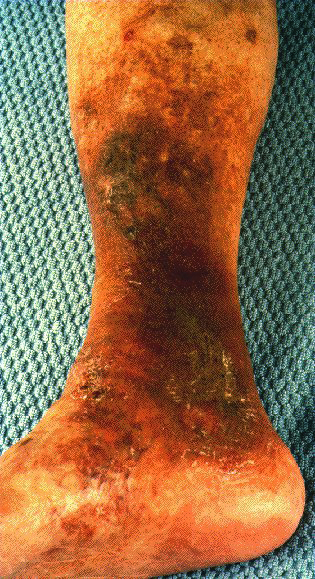 |
|
Bruising caused by burst veins |
Clotting/Healing: While zombies have fewer clotting factors than vampires, their lower bpm effectively evens out the rate of blood loss. However, the fact that zombies don't require as much blood volume allows them to survive being cut in half at the waist for roughly 1 to 3 minutes (compared to just 10 to 30 seconds for vampires). In addition, besides their nervous system, they can also heal any healthy tissue that isn't yet overtaken by necrosis, though it's a much slower process than with humans.
Organ Perforation: Because they feel much less pain than vampires, zombies barely notice injuries to the lungs and intestines—although a collapsed lung or two will definitely tire them more easily during extended encounters. As for the latter organ, the higher ratio of fecal bacteria to immune strength and healing ability makes such wounds ultimately fatal after a few days.